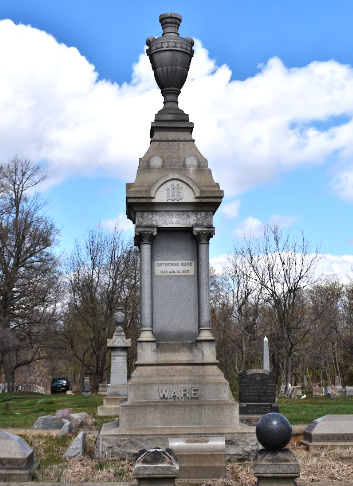Title: Truck farming heiress
Birthdate: 1827
Death Date: August 31, 1907
Plot Location: Section 130, Row A, Lots 17-18

Not many cemeteries can boast that one of their three tallest monuments pays tribute to a woman. This one clearly demonstrates that this person had great wealth. It’s one of the tallest in the cemetery, along with the Masonic column in the Circle of St. John and the monument to actor John McCullough in Section 149.
Catherine’s father was a truck farmer, which means he grew vegetables and other crops for sale to the public or to grocery stores. His farm was in “the Neck,” the southernmost part of the city which is now home to the sports stadiums. Her mother gave birth to two other girls and two boys.
Although farmers are not quick to part with their land, real estate is usually their largest asset. Farmers could become wealthy as they sold off some land and invested in other properties. John left a small fortune to his children because of his wise use of money. Catherine inherited properties worth $100,000 when he died in the late 1850s. In today’s dollars that would be $3.6 million.
It was Valentine’s Day of 1872 when, at age 45, she became the second wife of David Ware. His first wife, Emma Teal Ware, died young and left him with a daughter named Ella. She was 10 when her father remarried. They moved in with Catherine at 312 Federal Street, which wasn’t far from the river where David worked as a ship carpenter.
A blood clot stopped David’s heart in 1895. He was buried in another cemetery with his first wife, leaving everything he had to his daughter. What he had, however, was just $152 in cash and $25 in furniture and carpentry tools. Ella most likely had moved out since it was just six weeks later that she got married. (She and her husband were later buried at Mount Moriah.)
Catherine was wise to have kept her real and personal property in her own name. It turned out that she was living off the rental income of 28 residential properties. For 12 years after his death she lived alone with a parrot and three canaries.
property in her own name. It turned out that she was living off the rental income of 28 residential properties. For 12 years after his death she lived alone with a parrot and three canaries.
A person’s life story normally ends by reporting the death and burial, but it was how Catherine died that made the newspapers. One account says her neighbors knew her daily routine, which always started with opening the front shutters of her house. They knew she rarely left except to go to the market on Fridays but the shutters remained closed all day Saturday.
The other clue was the shrill cries that the neighbors heard coming from her parrot, as described in this report: “‘Mom! Mom!’ cried the bereaved parrot. ‘Mom! Mom!’ And not hearing the customary response from its eccentric mistress who seemed to love the bird with a devotion that led her to prefer its companionship to human kind, the parrot called out again in agonizing tones.”
bird with a devotion that led her to prefer its companionship to human kind, the parrot called out again in agonizing tones.”
When two neighbors decided to investigate, they broke in the front door, the parrot flew in their faces, and then back to the dining room where Catherine sat in a chair, asphyxiated. Two of her canaries lay dead in their cage.
They rushed to the kitchen and found the source of the problem. She had apparently brushed against the knob on her gas stove. Because of asthma, she sat down in the dining room to catch her breath. The fumes from the  stove filled the house and by the time she was aware of it she was too feeble to escape.
stove filled the house and by the time she was aware of it she was too feeble to escape.
Another example of her financial wisdom was she had already purchased a cemetery plot many years before, and had her father’s remains moved here. She was the last survivor of the five Wagner children so she must have arranged with them to use this plot. It includes her father, sisters, brothers, and a number of nieces and nephews. This black and white photo of her niece, Ann, gives perspective on the immense size of the monument, estimated at more than 30 feet.
Catherine directed in her will that certain houses be given to her nieces and nephews, and the remaining properties be sold to purchase a monument over her grave. She must not have realized how much that would be. While she did not live extravagantly, if she had known, perhaps she might have allocated her assets differently. But her executor had to comply with the terms of the will, and this was the result.

Support the Friends of Mount Moriah
Help us in our mission to restore and maintain the beautiful Mount Moriah Cemetery by donating to our cause or volunteering at one of our clean-up events.

